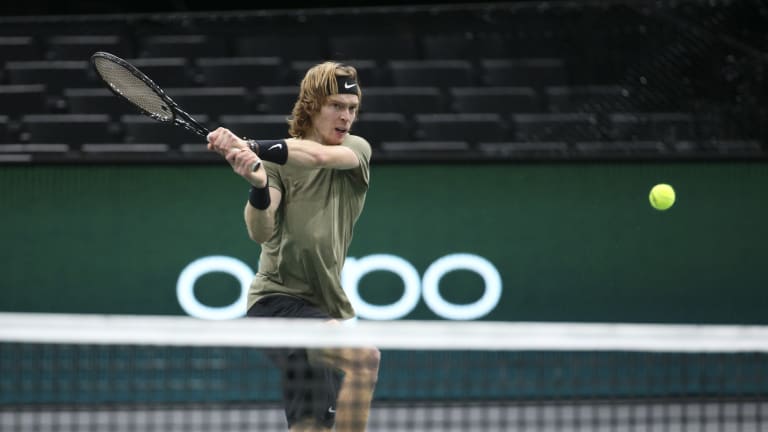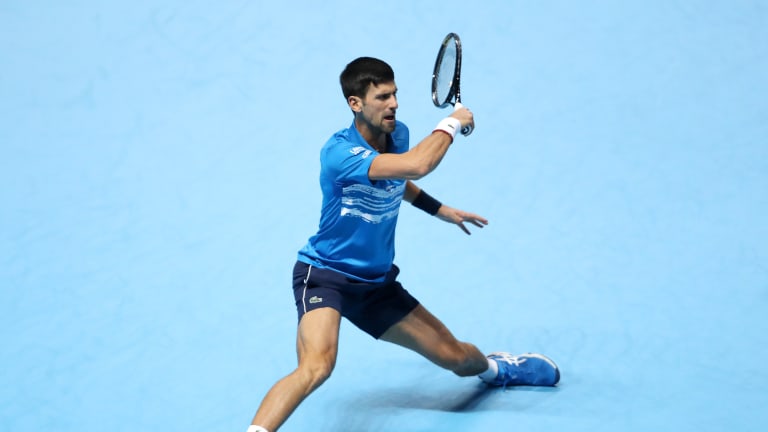ATP Finals
The Rally: Assessing—and saying goodbye to—the ATP Finals in London
Nov 13, 2020ATP Finals
Wanted: Faster Courts
By Peter Bodo Nov 20, 2023ATP Finals
Improving Jannik Sinner has his sights set on serving up more success next season
By Associated Press Nov 20, 2023ATP Finals
New Era, Same Emperor: Novak Djokovic reigns supreme in Turin
By Steve Tignor Nov 19, 2023ATP Finals
Record-breakovic! Novak Djokovic defeats Jannik Sinner for historic seventh ATP Finals title
By John Berkok Nov 19, 2023ATP Finals
Novak Djokovic vs. Jannik Sinner: 2023 ATP Finals Championship preview
By Steve Tignor Nov 19, 2023ATP Finals
Novak Djokovic shows Nick Kyrgios the commentator why he's the "best player to ever touch a racquet"
By Matt Fitzgerald Nov 18, 2023ATP Finals
Djokovic dispatches Alcaraz at ATP Finals to set up title match against home favorite Sinner
By Associated Press Nov 18, 2023ATP Finals
Novak Djokovic beats Carlos Alcaraz in straight sets in battle between No. 1 and No. 2 at ATP Finals
By John Berkok Nov 18, 2023ATP Finals
Jannik Sinner defeats Daniil Medvedev to reach biggest final of career at ATP Finals
By John Berkok Nov 18, 2023ATP Finals
The Rally: Assessing—and saying goodbye to—the ATP Finals in London
Before it relocates to Turin, the men's season-ending championship gives us one more tantalizing elite eight in England.
Published Nov 13, 2020
Advertising
Can Rafa finally get a win? Can Djokovic tie Federer? Which of the Next Genners stands the best chance? In this week's Rally, Joel Drucker and Steve Tignor preview the Nitto ATP Finals.
Hi Steve,
This year marks the 50th anniversary of the Nitto ATP Finals. Granted, that hasn’t always been the season-ending tournament’s exact name. It’s had several titles, including the Masters, and Tennis Masters Cup and the ATP World Tour Finals. Either way, the concept has always been the same—a year-end event for only the very best. Save for a few experiments with the classic elimination format in the 1980s, the format has remained the same, too: a round-robin with two groups, with the four players who fare best in each advancing to the semis.
The mix of a pristine indoor setting and small field often makes for lively tennis. I particularly like that the matches are scheduled in advance, eliminating the rather draining and speculative draw-casting that happens at every other tournament.
It’s also fun to see how the groups are named. This year, there’s the Group London 2020 (Rafael Nadal, Dominic Thiem, Stefanos Tsitsipas and Andrey Rublev), and the Group Tokyo 1970 (Novak Djokovic, Daniil Medvedev, Alexander Zverev and Diego Schwartzman)—the latter a nod to the event’s first incarnation (check out this article if you want to learn how different things were in those days).
Digging deeper into each group, it’s interesting to study these eight greats and take in the wide range of results each generated over the course of this heavily truncated tennis year, from the majors won by Djokovic, Thiem and Nadal, to the impressive ascent of such first-time participants as Rublev (who won five titles in 2020) and Roland Garros semifinalist Schwartzman.
There’s also an ample amount of stylistic diversity. Thiem and defending champion Tsitsipas represent the cause of the splendid one-handed backhand—and even they play quite differently from one another. Then there’s lanky and powerful Zverev, in the same group as the clever Medvedev. And of course, there’s Djokovic, seeking to tie Roger Federer’s record of six titles at this event—and Nadal, who’s never won it.
What intrigues you about this event, Steve, both past and present?

The Rally: Assessing—and saying goodbye to—the ATP Finals in London
© Getty Images
Advertising
No one may be playing better tennis right now than Rublev, who will seek his sixth title of the truncated season. (Getty Images)
Hi Joel,
The ATP’s year-end championships are a mood, as they say, at least as viewed from across the Atlantic. The O2 Arena is dark, which matches the mood in New York, where it’s getting a little darker a little earlier each day. On the one hand, this tournament signals the start of a long winter ahead; on the other, it can feel like a holiday feast after an 11-month season. Each day, you know you’re going to get something worth digging into. This year’s edition will start with a double helping on Sunday: Thiem vs. Tsitsipas in the day session; Nadal vs. Rublev at night.
Like everything else this year, there will a different vibe at the O2 in 2020, for a couple of reasons. Because of the pandemic, there won’t be fans in the arena, though that may not matter as much at a tournament where it’s hard to see them anyway. And as for the players, they may feel as if the season is just swinging into gear, having just resumed play in August, rather than winding down. Will that make them fresher and more eager than other years? We’ll see.
Either way, I like this field, and I think it’s a good showcase for how the ATP is slowly transitioning from the Big 3 generation to the Next Gen. As you say, there’s a fair amount of stylistic variety, and, after Thiem’s US Open win, the clash of the generations feels like a fairer fight this time. I’m interested in whether Nadal can finally win the biggest title that has eluded him. Based on his level last week in Bercy, I have my doubts—indoor tennis will never be his thing.
Rafa’s legacy is beyond secure, but this tournament is still a conspicuous hole in his resume, when you consider that Federer and Djokovic have won it six and five times, respectively. Do you think Nadal should feel any special motivation to win it?
I’m also interested in first-timer Rublev. Rookies often take their lumps at this tournament, but the Russian has been the most prolific winner on tour in 2020. More than anything, I’m looking forward to settling in on dark afternoons and seeing how each of these heavyweight fights unfolds.
This event has had a great, profile-raising run in London over the last decade, Joel, but I’ll be happy to see it finally rotate onto Turin next year. How about you?

The Rally: Assessing—and saying goodbye to—the ATP Finals in London
© 2015 Getty Images
Advertising
Nadal, who has never won the ATP's season-ending championships, waves to the crowd in London in 2015. (Getty Images)
Steve,
No question, holding this event in London has raised its profile. Perhaps, thanks to Wimbledon, that’s due to London’s connection to a well-informed base of tennis fans who don’t just appreciate the sport—they know it. Coming to London for the last 20 years, I’ve had conversations about grips and tactics with a great many people. These are hardly casual sports fans.
Or maybe it’s the spacious yet intimate 02 Arena and its great sight lines that help spectators get involved with the tennis (though of course with no fans watching on-site, that won’t matter this year).
Or is that there’s often a local contender in Andy Murray, who’s qualified to play it eight times and clinched the world No. 1 ranking in London four years ago?
Then again, London’s success might well be as simple as the fact that titans Federer and Djokovic have between them won the tournament 11 times, including six time while the event was in London (two for Federer, four for Djokovic). Call it a variation of the Michael Jordan Effect: the chance to tell your friends and family that you saw one of the very best in person.
Yet as successful as the event’s been in London, I think a specific city should host it for no more than five years. That’s enough time to see if it’s possible to build sufficient traction both locally and globally the way London has. But I also believe it benefits the sport to spread the wealth and bring this fantastic player field and fun round-robin format to other parts of the world—many that are starving to see the greats up close. Let’s also what new wrinkles might come from a different city—from community involvement to entertainment elements. I’m intrigued to see what happens during Turin’s five-year-run.
I also think it would be interesting if the event experimented with different surfaces. Never has it been played on clay, and given the nature of contemporary tennis, that seems a logical possibility And why not grass? This happened once, in Melbourne at the end of 1974.
It would also be fascinating to once again hold the tournament outdoors. That’s only been the case three times: 1974 in Melbourne, and from 2002-03 in Houston. So what about holding it outdoors in Southern California at the Indian Wells Tennis Garden? Or, though logistically somewhat more complicated given player schedules, South America or Africa could be great spots for bringing in big-time tennis.
Any thoughts from you, Steve, on how to make a great event even better? And as far as London this year goes, what are some of the round-robin matchups you’re particularly interested in?

The Rally: Assessing—and saying goodbye to—the ATP Finals in London
© 2019 Getty Images
Advertising
Djokovic has won the ATP Finals five times, but not since 2015. (Getty Images)
Joel,
We’re in agreement on bringing variety to the ATP finals, both in terms of location and surface. To hold the event, say, on clay in South America for three years, would be a great way of showing that tennis is an egalitarian, internationalist game, and that no one way of playing it is superior to another.
To bring it back to this week, here are a few things I’m looking for:
Group London 2020
As I said, I’ll be curious to see how Rublev matches up against his idol, Nadal. I’m surprised to discover they’ve only played once, at the 2017 US Open. Rublev was overmatched, physically and mentally, that day, but he’s come a long way since. This could be a statement performance from him.
I’m also interested in how Thiem does. His US Open win was a long time coming, so much so that he seemed burned out at Roland Garros, and almost happy to hand the baton off to Schwartzman in the quarterfinals and go take a rest. What will his attitude be like here—and, more broadly speaking, will he suffer a longer letdown after his breakthrough? The Big 3 have always brought it for every tournament, but maybe that’s just not something we can expect from everyone.
Group Tokyo 1970
I’ll be interested in Medvedev here. He’s had a mostly down season, but he got back on the winning track in Bercy. The last two years, this tournament has been won by a Next Genner—Zverev in 2018, Tsitsipas in 2019. Medvedev would make a logical third in that triumvirate. It would constitute the biggest title of his career, and make us wonder if he’s the true player to watch in 2021.
As for Djokovic, how much does he care about tying Federer with six titles at this event? It may not be all that high on his to-do list, but he has a way of winning events like these anyway, whether they’re meaningful or not. After skipping Bercy, the world No. 1 will be rested, and if he gets a shot a avenging his Roland Garros loss to Nadal, you know he’ll be ready.